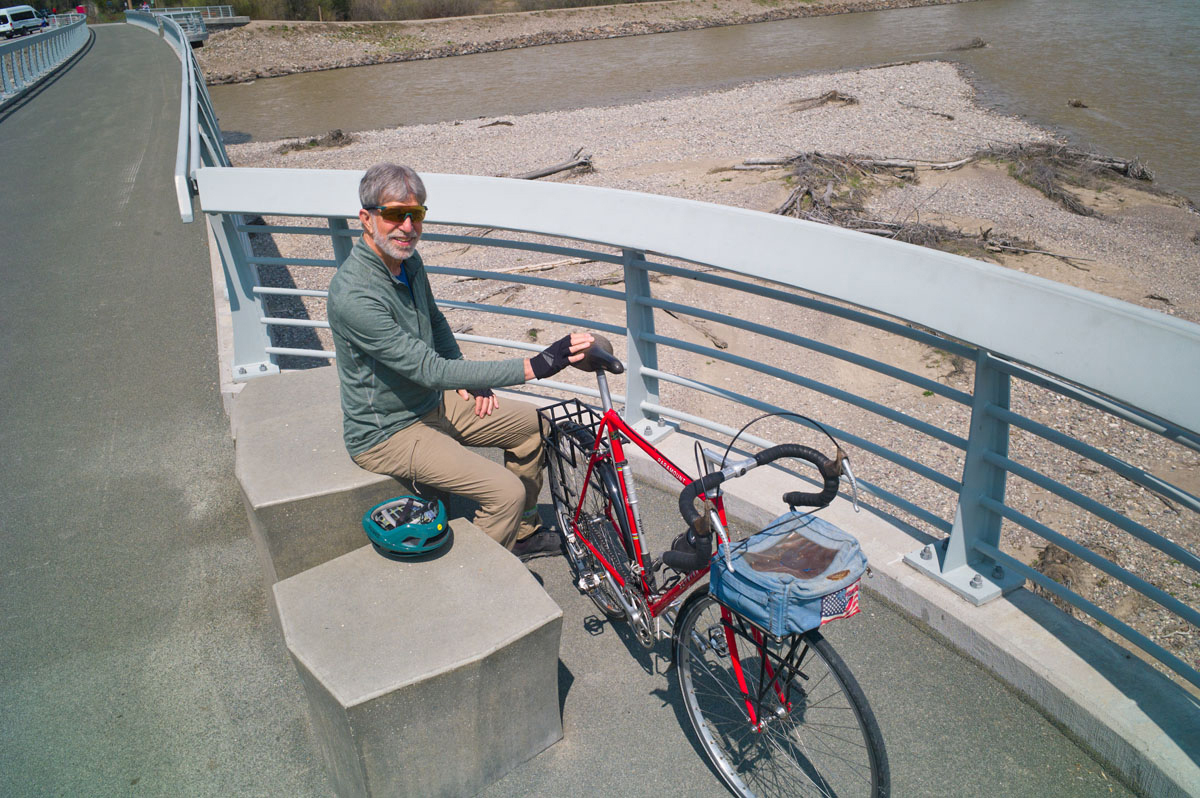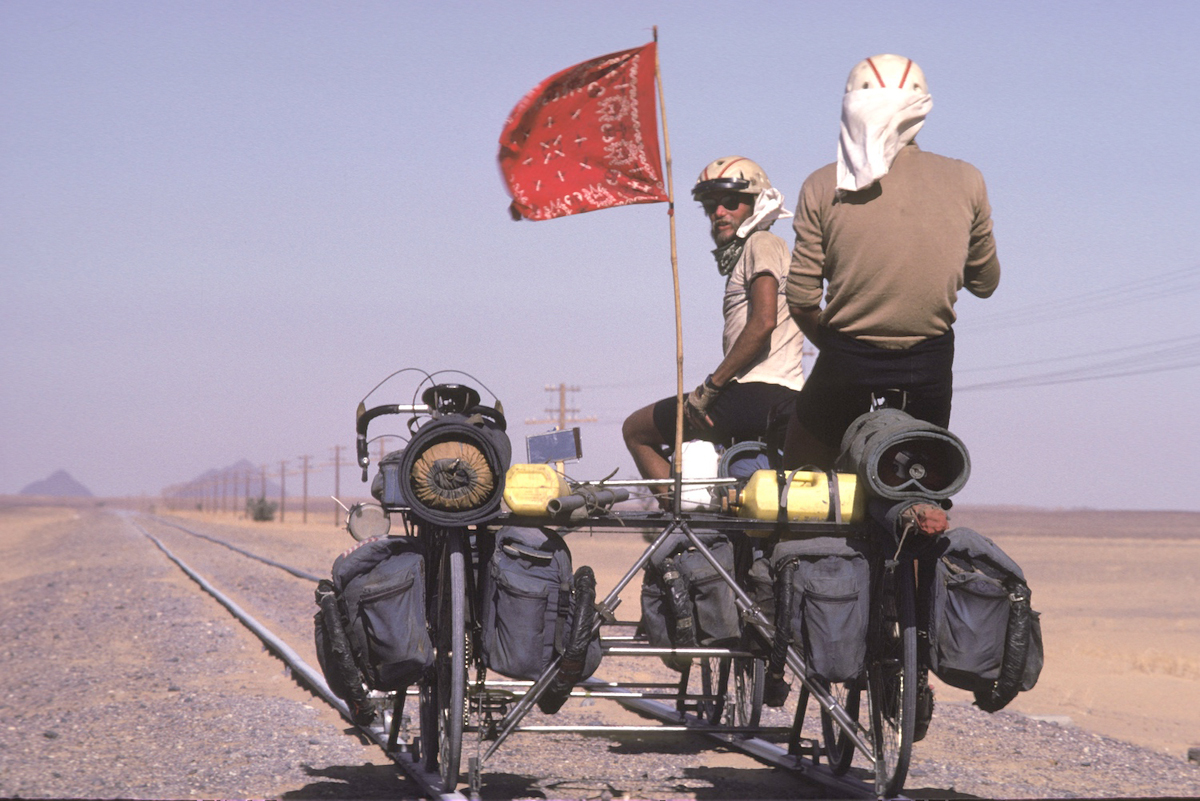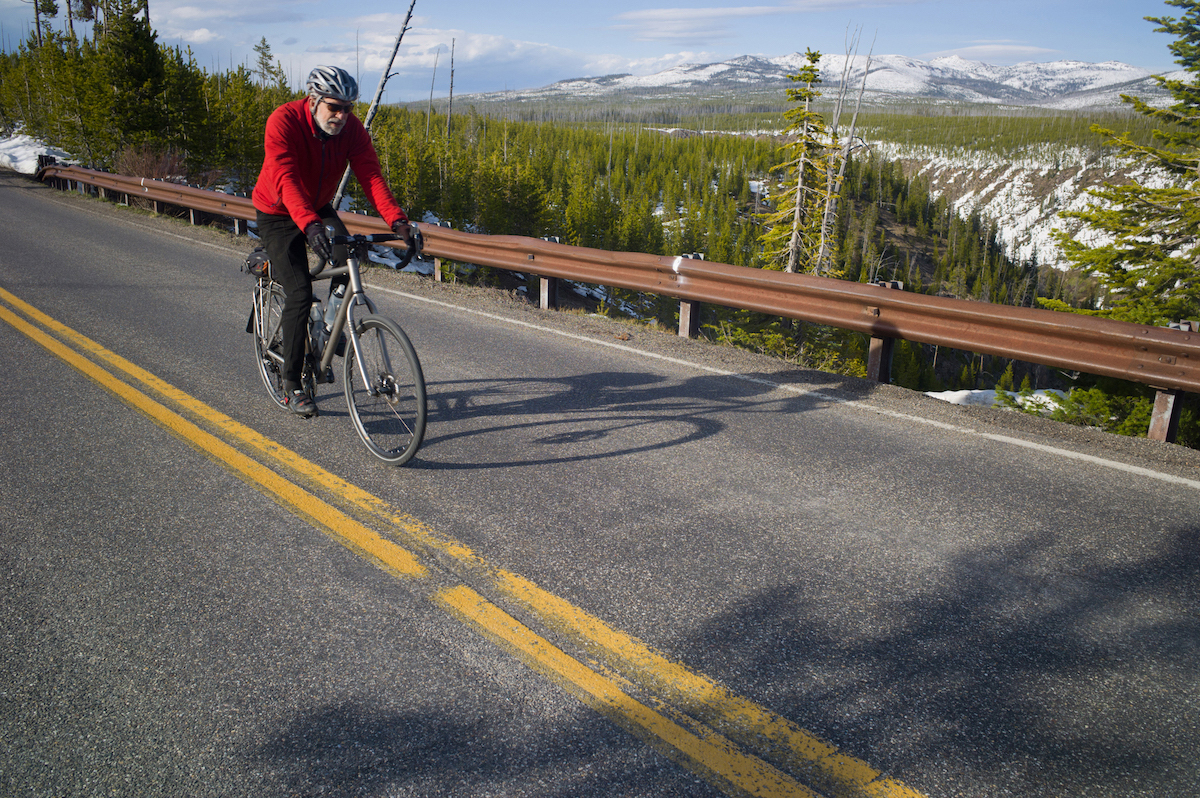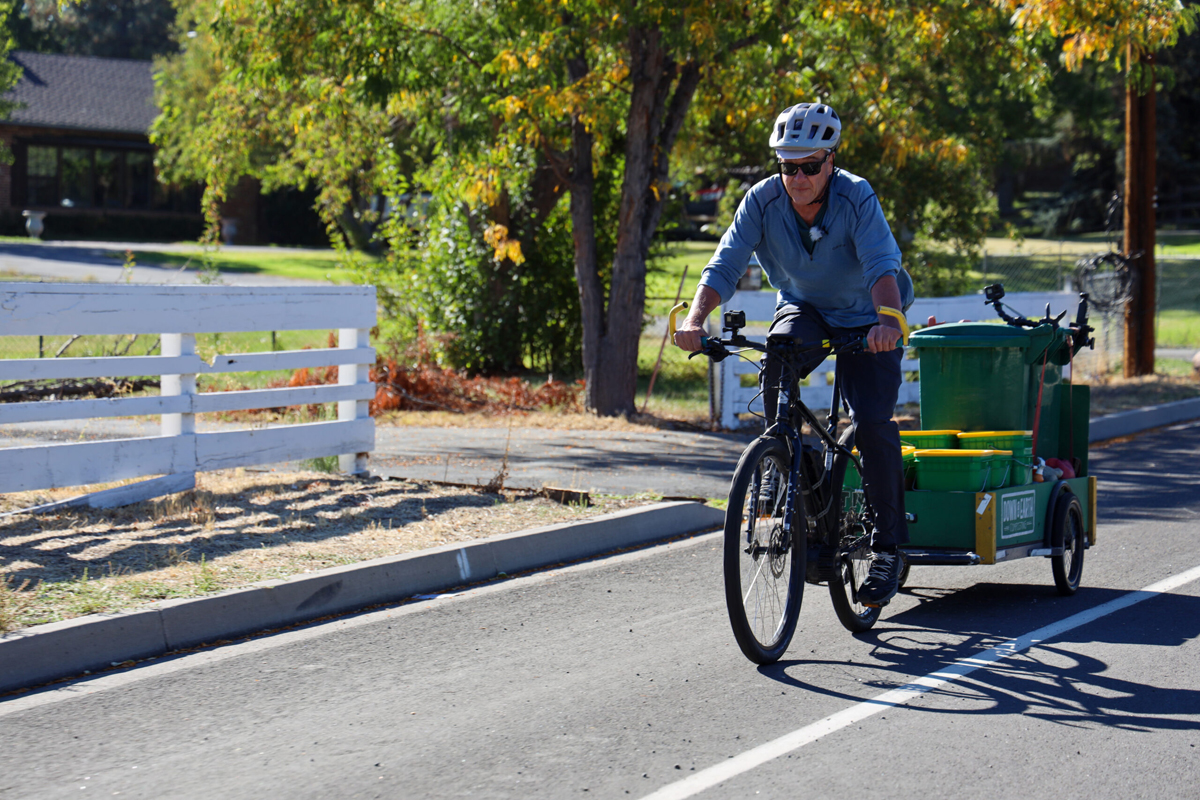By Katie Klingsporn, Wyofile.com — A passion for human-powered travel fueled a career advocating for and shepherding Wyoming path and road safety projects. In retirement, Young plans to spend time on the trails he helped make possible.
A passion for human-powered travel fueled a career advocating for and shepherding Wyoming path and road safety projects. In retirement, Young plans to spend time on the trails he helped make possible.
Hanging from the ceiling of Tim Young’s 500-square-foot log cabin office in Wilson is a cherry red 1980 Schwinn Paramount bicycle. Black fenders hug its tires, pannier racks are affixed front and back and the saddle is well worn.
Though the bike “still rolls quite good,” it’s in retirement, Young said.
As a younger man, Young pedaled the Schwinn 45,000 miles across some 50 countries and six continents in an epic expedition that spanned seven years. It was in its saddle that Young discovered how transformative bike touring can be and where he nurtured a passion for human-powered transportation. That passion steered Young’s life, fueling a decades-long career in active-transportation advocacy that has helped produce many miles of bike paths, trails and safe streets in Wyoming.
The work that goes into these projects is not as exciting as utilizing the end products — seeing them to fruition takes tenacity and stick-to-it-iveness as environmental reviews, agency partnerships and fundraising can drag for years. Yet, Young’s fingerprints are on so many Wyoming projects it’s tough to quantify, said Mike Kusiek, executive director of Wyoming Pathways — the advocacy organization Young co-founded.
“It’s a stellar amount of work that one person has had a vision for and … carried out,” Kusiek said. “Talk about staying the course and seeing it through.”
Young has worked quietly behind the scenes for decades to ensure the state is a more bikeable, walkable place. “It’s legacy work,” Kusiek said. “It’ll be how many generations from now? … we’ll still be benefiting from all the things he’s done to make Wyoming better.”

Jackson Hole Friends of Pathways Executive Director Katherine Dowson also considers Young visionary. He was out preaching the gospel of active transportation long before it was popular, she said.
“You don’t have to necessarily sell the concept of pathways and trails anymore,” she said. “The public uses them and they love them.” But when Young started his advocacy work, it was foreign.
“His ideas were well before their time,” she said.
Like the Schwinn, Young is retiring. But unlike the bicycle, Young won’t spend his retirement idly hanging out.
While he’s stepped away from his official position as project manager for Wyoming Pathways, he said, “I’m not going to retire as a bike advocate.”
He also intends to hit the trails he’s helped create.
“I’m going to go ride my bike some more,” he said.
The power of slow travel
Young grew up in central New York and attended SUNY Alfred College. As a student, too broke to afford a car, he rode his bike everywhere.
In 1975 at the age of 22, he moved to Jackson to ski and explore the mountains. He found everything he wanted there, he said. “So I stayed.”
Shortly after he landed he bought a new bike and started experimenting with bike touring — around Jackson, then Wyoming, then the world. He rode to Dubois with friends, toured Yellowstone on two wheels and flew to Europe to cycle from London to Athens and back.
“I realized bike touring was one of the best ways to travel, to see the world, to meet people,” he said. “You could actually get places, and the pace was slow enough to see something and learn something.”
Inspired, he and friends Peter Wuerslin and Steve Williams hatched their most ambitious itinerary: an international bike expedition. They pedaled out of Jackson in 1980, cycling south through Central America and on down to Buenos Aires, Argentina. That alone is a remarkable trek — and it was just the first leg of what they dubbed the Too Tyred Tour Around the World. Over the next seven years, they rode through Cape Town and Cairo, Karachi and Kathmandu, Perth and Hong Kong. They climbed over Himalayan highlands, hitchhiked on an Air Force jet, ski bummed in the Alps and got to know people of every stripe.

“It was quite an adventure,” Young said.
Wuerslin, who also still lives in Jackson, said it’s almost impossible to communicate how meaningful and experience-rich the trip was.
“We can tell a million stories, but it just can’t bring anybody there,” he said. “That’s how amazing it was.”
When they returned to Jackson, Young viewed his home through new eyes, he said. “It was certainly an inspiration for me seeing the opportunities in some places in the world for biking and walking, but realizing that even Jackson Hole was certainly not planning ahead for biking and walking.”
At the time, the county had no bike paths. His new interest led him to attend public meetings to talk about the importance of pedestrian and bike safety in planning. At a time when transportation discussions were almost exclusively focused on highways and vehicles, he said, the concept “was sort of revolutionary.”
In Jackson, though, it struck a chord. Local officials initiated a citizens’ task force to look into it. Young volunteered for the task force around 1990.
“That’s probably the start of my official bike advocacy career,” he said.
New path
Young had a degree in food distribution, and had previously worked with local supermarkets and as a product manager for Jackson-based Life-Link International, which made Croakies and other gear.
But once he joined the task force, what unfolded was a 30-year career in government and nonprofit bike, pedestrian and trails programs. It grew organically; a passion sowed seeds for identifying needs that then fueled opportunities to help shape projects.
Bike touring sharpened skills he would rely heavily on, he said. He learned to write grants while seeking sponsorship of the world trip, and it demanded on-the-fly problem solving and logistical organization. He also needed to communicate well with his co-travelers along with bureaucratic officials, which underscored the benefit of partnerships.
Young served as chairman of the Jackson task force, which wrote the county and town’s first conceptual pathways plan — an award-winning document that won favor from local leaders.
The county then offered Young a job; in 1992 he became Teton County’s first pathways director. He held that position for 10 years, leading the planning and execution of several miles of local trails and paths as well as sidewalk plans.

He learned a lot about government planning, but also saw how crucial grassroots bicycle advocacy can be in galvanizing support and making things happen, he said. He still has the workbook he received as a participant in an advocacy training early in his career, which opens with a Margaret Mead quote he admires: “Never doubt that a small group of thoughtful committed citizens can change the world. Indeed, it’s the only thing that ever has.”
So in 1994, he founded Friends of Pathways in Jackson, though he initially didn’t work for it beyond getting it off the ground. The nonprofit organization has gone on to facilitate many projects. Teton County now has 70 miles of paved path, plus an additional 16 miles in Grand Teton National Park.
Taking it statewide
Young’s work took him beyond county lines. He formed a relationship with Wyoming’s Department of Transportation, learned how to tap into federal funding opportunities and sat on a state committee to award transportation enhancement money. He helped start an alliance of state and local bicycle advocacy groups, lobbied in D.C. and worked to create pathways in Grand Teton National Park following a high-profile fatality.
He returned to Friends of Pathways to serve as its director in 2006, extending the organization’s reach including work with the U.S. Forest Service to construct and improve trails.
The notion of having a statewide bike advocacy group had long hung in his mind, and in 2012 Young co-founded Wyoming Pathways with Todd Thibodeau and Bruce Burrows. He served as its director for 10 years.
A lot of that work, he said, entailed traveling to Wyoming communities to understand their local needs, and then helping match those needs to opportunities like funding or planning.
The group connected advocates with officials and lobbied the Legislature. Pathways pushed a bill that created a state bicycle and pedestrian task force. Young chaired that task force, which in 2018 produced the Wyoming Bicycle Pedestrian Report.
The group also initiated trail partnerships around the state with public land agencies like the Bureau of Land Management and Forest Service. It facilitated “charrettes” in communities, worked with towns like Thermopolis to plan trails and helped advance the 180-mile Greater Yellowstone Trail System. Pathways also launched a survey in 2021 to gauge statewide interests and needs. Respondents named greenways, pathways, safe school routes, crosswalks and more.
Young stepped away from the director role in 2022 before deciding to officially retire.
Reflecting on Young’s work, current Wyoming Pathways Director Kusiek said he’s not sure Wyoming’s well-loved pathways would exist without Young.
Many in the trails realm, Kusiek said, “they’re like, ‘oh my gosh, what an unfillable gap in the cosmos of Wyoming human-powered activities.’”
Happy trails
Young intends to stay involved in local trail issues, with an eye on national park improvements. He’s also going to do what he loves best. He’s got a bike tour of the Greater Yellowstone Trail System planned for June.
He’s enjoyed fighting for things he considers “building blocks for successful communities.”
Thinking back to that around-the-world expedition, Wuerslin said he saw traits that have carried Young through his career: persistence, patience and the ability to move forward with a really big idea.
“When I think of Tim, his strengths were the exact strengths that led him to what he did after the trip … he really could sit down with whatever problem we had and sort of plan out a plan and then go execute it,” he said.
Kusiek and Dowson both credit Young with fundamentally changing the nature of transit in Wyoming.
Young considers his work just the beginning. “Absolutely, I think there’s more to be done.” Both for the statewide group and for citizens who want to make a difference.
“It goes back to the Margaret Mead quote … ‘a small committed group of people can change the world,’” he said. “I do believe that. And I think that’s good advice going forward.”
Katie Klingsporn is WyoFile’s managing editor. She is a journalist and word geek who has been writing about life in the West for 15 years. Her pieces have appeared in Adventure Journal, National Geographic Adventure and Patagonia’s Cleanest Line blog.
WyoFile is an independent nonprofit news organization focused on Wyoming people, places and policy.








